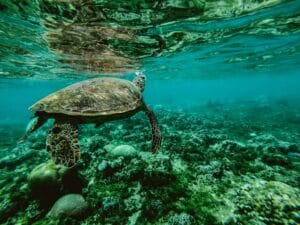
Source: Jeremy Bishop on Pexels
The Western Australian Department of Biodiversity, Conservation and Attractions (DBCA) has officially published the zoning scheme for the Bardi Jawi Gaarra Marine Park. Located in the Kimberley region of Western Australia, the state government and Bardi and Jawi traditional owners jointly manage the park. This significant milestone is the culmination of years of planning. It demonstrates what can be achieved when governments choose to work together with Indigenous peoples to further Indigenous-led conservation (National Geographic, 2022).
Planning began in 2022, with a management plan that opened with the words “Amboorin amboonoo angallala jard booroo”. Translated from the Bardi language, the phrase proposes “People, together let’s look after the country good”. The document, co-created by DBCA and The Bardi and Jawi Niimidiman Aboriginal Corporation RNTBC (BJNAC), outlined the environmental and cultural importance of the area and the ways it could be jointly managed in a way that would improve nature conservation, preserve and promote culture and heritage, and support use for future generations (DBCA, 2022).
The park, which covers 204,000 hectares of Bardi and Jawi Sea Country, features islands, reefs, and intertidal systems. The area is deeply connected to Aboriginal Australian lore. It is also a haven for snubfin dolphins, humpback whales, manta rays, and several threatened species of turtles. The new zoning system divides the area into four zones: general use, sanctuary, special purpose (biocultural conservation), and special purpose (cultural protection). These zones highlight not only the importance of environmental conservation, but also of Indigenous-led cultural conservation.
Sanctuary Zones and Marine Life
The newly defined sanctuary zones will provide the highest possible level of protection for marine habitats and wildlife. These zones include mangrove-lined creeks, numerous marnany (reefs) and noomool (seagrass meadows), which provide nursery areas for aarli (fish) and goorlil (turtles). Between May and July, visitors to the park include odorr (dugongs), while from June to November, miinimbi (humpback whales) migrate to the park.
The special purpose zones (cultural protection) will protect and conserve areas that are culturally significant to the Bardi and Jawi people. These areas include features such as seasonal camping grounds, areas that are important for cultural food and resources, and areas related to Law, ceremony, and oral histories.
The special purpose zones (biocultural conservation) aim to protect ecologically and culturally important areas. As well as allowing for some low-impact recreational and commercial activities. As such, these areas will now require that activities are conducted in a culturally appropriate manner. Activities deemed to be high impact are no longer allowed within the protected areas.
The new zoning laws are being phased in and will fully come into effect by July 2026. Congratulations, Western Australia! We look forward to seeing more innovations like this in the future.
Read about other topics surrounding marine conservation on our Ocean Governance page.
Read other news articles about ocean health from THRIVE.























